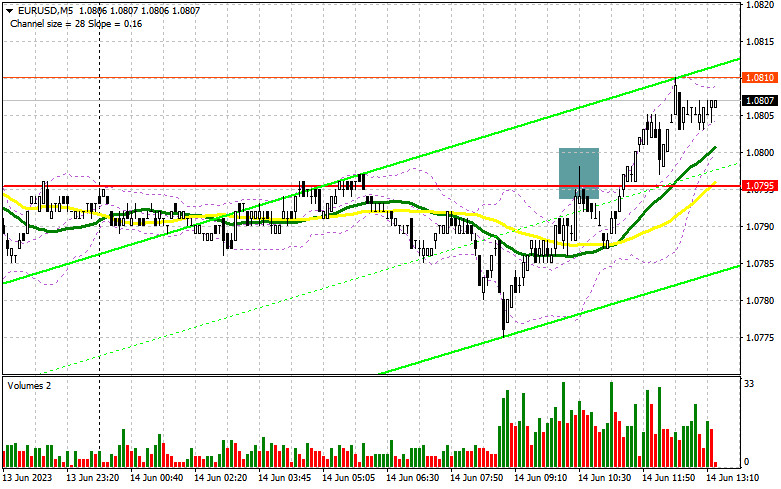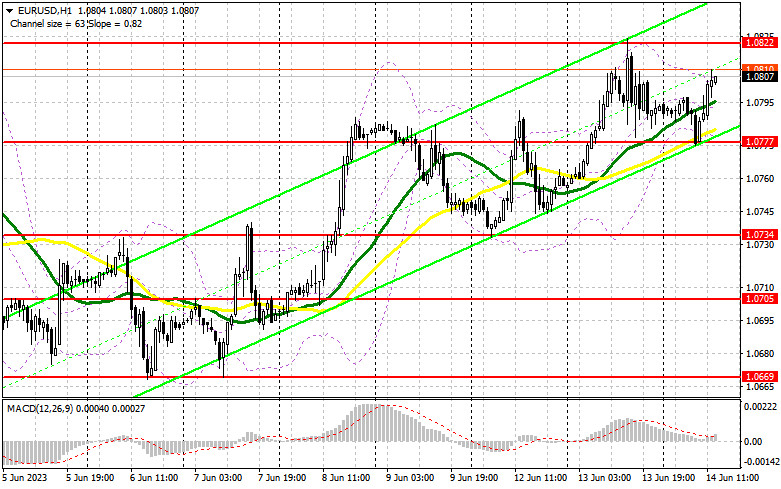
In my morning forecast, I drew attention to the level of 1.0795 and recommended making trading decisions based on it. Let's look at the 5-minute chart and analyze what happened there. The rise and formation of a false breakout at 1.0795 provided a sell signal for the euro, but there was no significant downward movement. The technical picture stayed mostly the same for the second half of the day.

To open long positions on EUR/USD, the following is required:
Everyone is waiting for the decision of the Federal Reserve on interest rates. The committee is expected to make the first pause in the 15-month tightening cycle of monetary policy, which is positive for the European currency and negative for the US dollar. Much will depend on the statements of Fed Chairman Jerome Powell, who will likely reiterate the speech from May that the fight against inflation is not yet over, which may limit the upside potential for the euro. However, in a more medium-term perspective, there is a good opportunity for further growth in EUR/USD. It is also important to consider the US Producer Price Index data. An increase in the indicator could lead to a temporary decline in the euro, which can be used to open long positions.
I will act on the decline and false breakout around the support level of 1.0777, formed during the day, and where the moving averages, favoring buyers, are located. This will provide an opportunity to enter long positions with the target of another rise to 1.0822. A breakthrough and test of this range from top to bottom are necessary for buyers, as it will strengthen the demand for the euro and provide an additional entry point for increasing long positions with an update towards the next level of 1.0870. The ultimate target remains in the area of 1.0903, where I will take profits.
With a decline in EUR/USD and the absence of buyers at 1.0777, pressure on the euro will return, but it will not last long. The formation of a false breakout around the next support level of 1.0734, this week's low, will signal to buy opportunities for the euro. I will open long positions immediately on a rebound from 1.0705 with the target of an upward correction within 30-35 points intraday.

To open short positions on EUR/USD, the following is required:
Bears have nothing to rely on, so all attempts to lower the euro are failing. Everything will be determined by inflation data in the US and statements by Chairman Powell, as the Fed's decision is obvious. For this reason, it is better to take your time with selling in the second half of the day. I will act only after another unsuccessful consolidation above the resistance level of 1.0822. A false breakout at this level will signal to sell, capable of pushing the pair back to 1.0777, where the moving averages, favoring bulls, are located. A consolidation below this range and a reverse test from below to above will pave the way to 1.0734. The ultimate target will be in the area of 1.0705, where I will take profits.
If EUR/USD moves upward during the American session and there are no bears at 1.0822, which is most likely, the demand for the euro will only strengthen, leading to a more powerful surge in the pair's value. In that case, I will postpone short positions until a new resistance level of 1.0870. It can be sold, but only after an unsuccessful consolidation. I will open short positions immediately on a rebound from the maximum level of 1.0903 with the target of a downward correction within the 30-35 points range.
In the Commitment of Traders (COT) report for June 6th, there was a decrease in long positions and a slight increase in short positions. Despite all this, the Federal Reserve's decision on interest rates this week can significantly change the market's balance of power, so the abovementioned changes may be less relevant. If the Fed pauses the rate hike cycle, the euro will gain significant weight, while the US dollar will weaken. Along with the continuation of the aggressive policy by the European Central Bank, despite the initial signs of a slowdown in underlying inflationary pressures, all this will lead to the further growth of risk assets against the US dollar. According to the COT report, non-commercial long positions decreased by 5,757 to 236,060, while non-commercial short positions increased by 1,457 to 77,060. The overall non-commercial net position decreased to 158,224 from 163,054. The weekly closing price decreased to 1.0702 from 1.0732.
Indicator signals:
Moving Averages
Trading is conducted above the 30-day and 50-day moving averages, indicating the likelihood of the euro's rise. Note: The author considers the period and prices of the moving averages on the H1 hourly chart, which differs from the general definition of classical daily moving averages on the D1 daily chart.
Bollinger Bands
In case of an upward trend, the upper boundary of the indicator around 1.0810 will act as resistance.
Description of Indicators
• Moving Average (determines the current trend by smoothing out volatility and noise). Period 50. Marked in yellow on the chart.
• Moving Average (determines the current trend by smoothing out volatility and noise). Period 30. Marked in green on the chart.
• MACD Indicator (Moving Average Convergence/Divergence) - Fast EMA period 12, Slow EMA period 26, SMA period 9.
• Bollinger Bands - Period 20.
• Non-commercial traders - speculators such as individual traders, hedge funds, and large institutions using the futures market for speculative purposes and meeting certain requirements.
• Long non-commercial positions represent the total long open positions of non-commercial traders.
• Short non-commercial positions represent the total short open positions of non-commercial traders.
• The overall non-commercial net position is the difference between non-commercial traders' short and long positions.